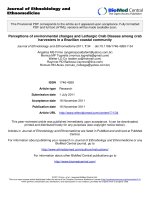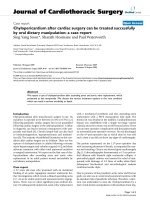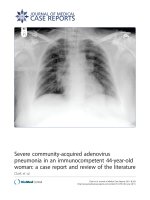Báo cáo y học: "Treatment of stasis dermatitis using aminaphtone: Graves’ disease presenting as pseudotumor cerebri: a case report." docx
Bạn đang xem bản rút gọn của tài liệu. Xem và tải ngay bản đầy đủ của tài liệu tại đây (366.05 KB, 2 trang )
CAS E REP O R T Open Access
Graves’ disease presenting as pseudotumor
cerebri: a case report
Ester Coutinho
1*
, Ana M Silva
2
, Cláudia Freitas
1
, Ernestina Santos
1
Abstract
Introduction: Pseudotumor cerebri is an entity characterized by elevated intracranial pressure with normal
cerebrospinal fluid and no structural abnormalities detected on brain MRI scans. Common secondary causes
include endocrine pathologies. Hyperthyroidism is very rarely associated and only three case reports have been
published so far.
Case presentation: We report the case of a 31-year-old Luso-African woman with clinical symptoms and
laboratory confirmation of Graves’ disease that presented as pseudotumor cerebri.
Conclusion: This is a rare form of presentation of Graves’ disease and a rare cause of pseudotumor cerebri. It
should be remembered that hyperthyroidism is a potential cause of pseudotumor cerebri.
Introduction
Pseudot umor cereb ri (PTC) is an entity characterized by
elevated intracranial pressure with normal cerebrospinal
fluid(CSF)andnostructural abnormalities detected on
brain MRI scans. The neurological symptoms and signs
can be totally attributed to intracranial hyper tension, and
these include headaches, tra nsient visual obscurations,
visual loss and intracranial tinnitus, papilledema being the
hallmark of PTC. This syndrome includes both idiopathic
and secondary causes. Common secondary causes include
endocrine pathologies. Thyroid disturbances have a
unique correlation, since hypothyroidism, hyperthyroidism
and thyreostimulin suppression hormone therapy have all
been reported in association with this disorder. Hyperthyr-
oidism is very rarely associated with the disorder and only
three case reports [1-3] have been published to date, one
of them [3] in association with hypovitaminosis A.
Case presentation
A 31-year-old Luso-African woman w ho was a law stu-
dent was admitted to our department. She was slim
(body mass index (BMI) of 22), with no relevant medical
history and not taking any drugs. She presented with pro-
gressive sym ptoms: persistent headache and vomiting
that had lasted for six months accompanied by visual dis-
turbance (’blurred vision’) in the last few days. She also
stated she had pain with ocular movements and neck
stiffness. She had also shown clinical symptoms and signs
(tremor, diarrhea, tachycardia, heat intolerance and
exophthalmus) for the past five months suggestive of
hyperthyroidism. On neurological examination she pre-
sented with bilateral papilledema and nuchal rigidity.
Goldmann visual fields showed bilateral enlargement of
the blind spot. Results of a brain M RI with venography
were normal (Figure 1). Her CSF opening pressure was
raised (410 mm of wate r), had no cel ls, wi th normal glu-
cose and protein levels. A lumbar puncture to relieve
pressure was not performed; the diagnostic lumbar punc-
ture caused no symptomatic relief. Blood analysis showed
a totally suppressed thyroi d-stimula ting hormone level of
0.01 mIU/L (normal 0.35 to 4.50 mIU/L) and a free T3
levelof31.6pmol/L(normal3.5to6.5pmol/L).Athyr-
oid-stimulating hormone receptor antibody value of 49
U/L and thyroid scintigraphy showing a diffusely
increased radiotracer uptake goiter (Figure 2) confirmed
the diag nosis of Graves’ disease. Other etiological causes
were excluded via blood and CSF analysis, namel y infec-
tious and immunological diseases. Pharmacological
causes were excluded since she was not taking any drugs.
Treatment with tiamazol (30 mg/day), propranolol
(120 mg/day) and acetazolamide (1500 mg/day) was
given. After 10 days of treatment she had no headaches,
* Correspondence:
1
Serviço de Neurologia, Hospital Santo António, Largo Professor Abel Salazar,
4099-001 Porto, Portugal
Full list of author information is available at the end of the article
Coutinho et al. Journal of Medical Case Reports 2011, 5:68
/>JOURNAL OF MEDICAL
CASE REPORTS
© 2011 Coutinho et al; licensee BioMed Central Ltd. This is an Open Access article distributed under the terms of the Creative
Commons Attribution License ( /licenses/by/2.0), which permits unrestri cted use, distribution, and
reproduction in any medium, provided the original work is properly cite d.
nausea or vomiting. The papilledema resolved in the fol-
lowing months. She continued acetazolamide treatment
for four months and is currently being treated with tia-
mazol. Her thyroid function slowly recovered.
Conclusion
Considering that other causes were excluded and there
was neurological improvement once hyperthyroidism
treatment was started, a relationship between hyperthyr-
oidism and PTC can be assumed. Although acetazola-
mide was also used during the symptomatic phase, and
this could represent a confounder, we are convinced
that the thyroid disease treatment was the major reason
for improvement. This is a rare form of presentation of
Graves’ disease and a rare cause of PTC.
The pathophysiologic basis of PTC is still a matter of
debate, but a relationship has been established [4,5] with
elevated intracranial venous pressure. The increase in
resistance of CSF absorption is thought to be caused by
an insufficiently high driving pressure gradient from the
subarachnoidal space to the venous system. Thyroxine,
being a major regulator of sodium transport, can contri-
bute to altered CSF dynamics. The effect of thyroid hor-
mone raising venous pressure may justify the association
between those two entities. In fact, there is a pr eviously
reported association between thyrotoxicosis and cerebral
vein thrombosis [6], with additional procoagulant influ-
ences probably required in such cases.
We would like to emphasize that hyperthyroidism
should be considered among the causes of PTC and that
this association should be given further attention. Optic
fundus examination with screening for papilledema in
patients with thyroid diseases could detect more patients
with intracranial hypertension, helping to preven t visual
sequelae.
Consent
Written informed consent was obtained from the patient
for publication of this case report and any accompany-
ing images. A copy of the written consent is available
for review by the Editor-in-Chief of this journal.
Author details
1
Serviço de Neurologia, Hospital Santo António, Largo Professor Abel Salazar,
4099-001 Porto, Portugal.
2
Serviço de Endocrinologia, Hospital Santo
António, Largo Professor Abel Salazar, 4099-001 Porto, Portugal.
Authors’ contributions
EC analyzed and interpreted the data regarding the neurological
presentation of the disease, and was the major contributor in writing the
manuscript. AMS analyzed and interpreted the data regarding the
endocrinological aspects of the case. CF analyzed the endocrinological data
and is responsible for the follow-up of our patient. ES analyzed the
neurological data, is responsible for the follow-up of our patient and was an
active contributor for the writing of the manuscript. All authors read and
approved the final manuscript.
Competing interests
The authors declare that they have no competing interests.
Received: 22 October 2009 Accepted: 15 February 2011
Published: 15 February 2011
References
1. Dickman MS, Somasundaram M, Brzozzwski L: Pseudotumor cerebri and
hyperthyroidism. N Y State J Med 1980, 80:1118-1120.
2. Merkenschlager A, Ehrt O, Müller-Felber W, Schmidt H, Bernhard MK:
Reversible benign intracranial hypertension in a child with
hyperthyroidism. J Pediatr Endocrinol Metab 2008, 21:1099-1101.
3. Roos RA, Van der Blij JF: Pseudotumor cerebri associated with
hypovitaminosi A and hyperthyroidism. Dev Med Child Neurol 1985,
27:246-248.
4. Skau M, Brennum J, Gjerris F, Jensen R: What is new about idiopathic
intracranial hypertension? An updated review of mechanism and
treatment. Cephalalgia 2005, 26:384-399.
5. Bateman GA: Arterial inflow and venous outflow in idiopathic intracranial
hypertension associated with venous outflow stenoses. J Clin Neurosci
2008, 5:402-408.
6. Squizzato A, Gerdes VEA, Brandjes DPM, Büller HR, Stam J: Thyroid diseases
and cerebrovascular disease. Stroke 2005, 36:2302-2310.
doi:10.1186/1752-1947-5-68
Cite this article as: Coutinho et al.: Graves’ disease presenting as
pseudotumor cerebri: a case report. Journal of Medical Case Reports 2011
5:68.
Figure 1 Brain MRI scan with venography. A brain MRI scan
showing normal morphology, ventricular dimensions and venous
drainage.
Figure 2 Thyroid scintigraphy. Technetium 99 m pertechnetate
thyroid images showing the goiter with diffusely increased
radiotracer uptake.
Coutinho et al. Journal of Medical Case Reports 2011, 5:68
/>Page 2 of 2









